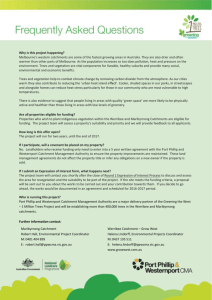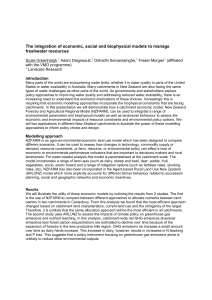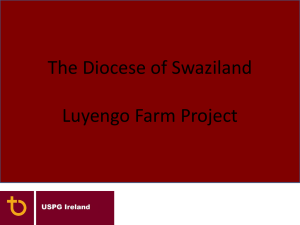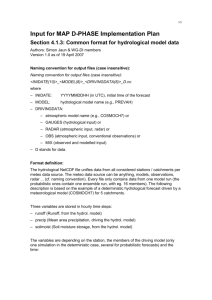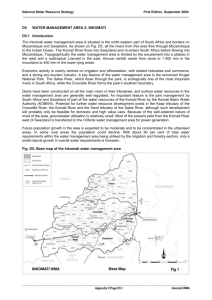MANAGING WATER UNDER CLIMATE CHANGE FOR PEACE AND
advertisement
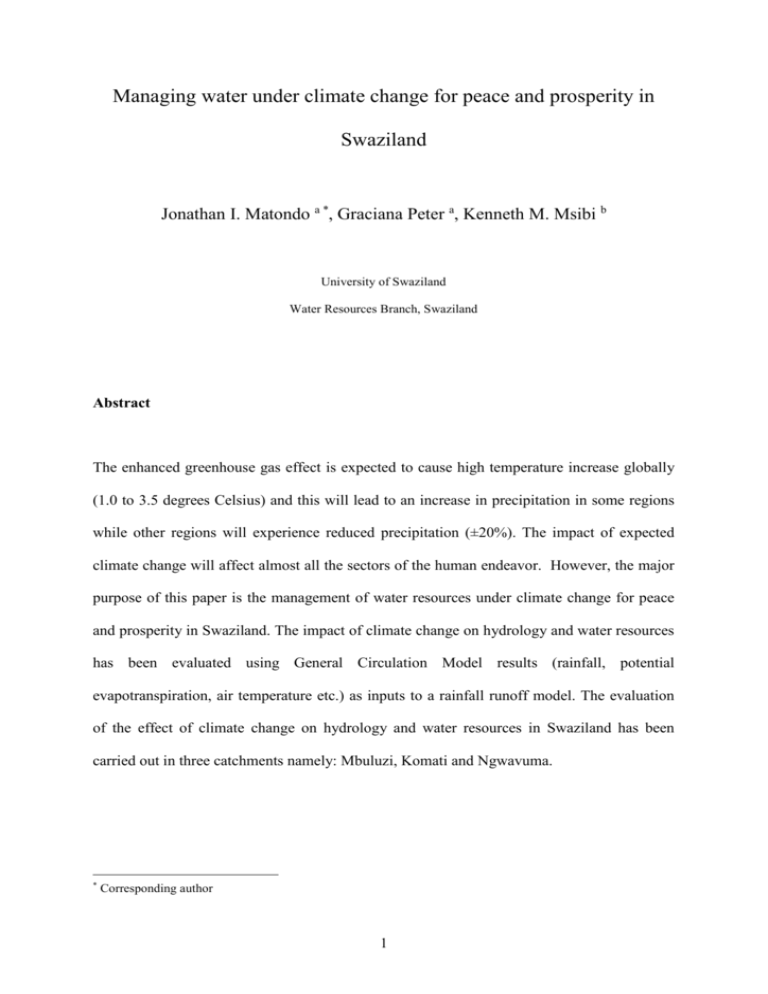
Managing water under climate change for peace and prosperity in
Swaziland
Jonathan I. Matondo a *, Graciana Peter a, Kenneth M. Msibi b
University of Swaziland
Water Resources Branch, Swaziland
Abstract
The enhanced greenhouse gas effect is expected to cause high temperature increase globally
(1.0 to 3.5 degrees Celsius) and this will lead to an increase in precipitation in some regions
while other regions will experience reduced precipitation (±20%). The impact of expected
climate change will affect almost all the sectors of the human endeavor. However, the major
purpose of this paper is the management of water resources under climate change for peace
and prosperity in Swaziland. The impact of climate change on hydrology and water resources
has been evaluated using General Circulation Model results (rainfall, potential
evapotranspiration, air temperature etc.) as inputs to a rainfall runoff model. The evaluation
of the effect of climate change on hydrology and water resources in Swaziland has been
carried out in three catchments namely: Mbuluzi, Komati and Ngwavuma.
*
Corresponding author
1
MAGICC - Model was used to simulate the climate parameters for Swaziland given the
baseline conditions. Eleven GCMs were used and three of them were found to simulate very
well the observed precipitation for Swaziland. These GCMs are: the Geophysical Fluid
Dynamics Laboratory (GFDL), the United Kingdom Transient Resalient (UKTR), and the
Canadian Climate Change Equilibrium (CCC-EQ). The three GCMs were used to project the
temperature and precipitation changes for Swaziland for year 2075. This information was
used to generate the temperature, precipitation and potential evapotranspiration values for the
three catchments for year 2075. This information was used as input data to a calibrated
WatBall rainfall runoff model. Simulation results (after taking into consideration of water use
projections) show a water deficit from June to September in both the Komati and Ngwavuma
catchments and a water deficit from May to September in the Mbuluzi catchment. Efficient
water utilization in the agricultural sector (i.e. using drip irrigation) gives a water savings of
33.6x106 m3 per year ( 1.065 m3/s), 47.6x106 m3 per year (1.509 m3/s) and 16.8x106 m3 per
year (0.533 m3/s) in the Komati, Mbuluzi and Ngwavuma catchments respectively. The saved
water could be used for economic activities, thus prosperity and meeting Swaziland’s
obligation to the down steam riparian states of South Africa and Mozambique and therefore
alleviating conflict between them and therefore the sustainability of peace.
1. Introduction
The greenhouse gases effect is expected to cause global warming which in turn will cause
changes in average precipitation for any region in the order of plus or minus 20%
(WMO/ICSU/UNEP, 1989). Generally it is expected that floods now considerd rare would
occur more frequently in certain regions while drought related and competing water use
2
issues will intensify in other regions (Miller, 1989; Shaakee, 1989; 1PCC 1990).Therefore,
there is a need to evaluate the impact of climate change on hydrology and water resources at
the local level. The assessment of the impact of expected climate change on water resources
involves the use of GCM models coupled with hydrologic models (Kunz, 1993). This
approach has been used in three catchments.
Simulation results in the three catchments for the considered climate change scenarios and for
dry, wet and average year conditions without taking into consideration of the water
abstractions are presented in Matondo et al (2003). The impact of expected climate change on
hydrology and water resources in Swaziland, while taking into consideration of the projected
water demand in the three catchments are presented in this paper.
2. Background information
The Kingdom of Swaziland, is situated in South Eastern Africa between the 25th and 28th
parallels and longitudes 31o and 32o East. It lies some 48 to 225 kilometres inland of the
Indian Ocean littoral and hence physically landlocked, meaning all traffic in and out of the
country has to be routed via one of its neighbours, South Africa or Mozambique. The
country has a total surface area of 17,360 km2 and as such, the smallest country in the
southern hemisphere.
It is bounded by the Republic of South Africa in the north, west and south, and by
Mozambique on the east. Although small in size, Swaziland is characterized by a great
3
variation in landscape, geology and climate. It also lies within the Maputoland Centre, an
area reported to have the greatest biodiversity in Southern Africa.
There are four distinct physiographic regions within the country namely: highveld,
middleveld, lowveld and lubombo, which are clearly distinguished by elevation and relief
(Murdoch, 1970). Swaziland enjoys a climate which is generally subtropical, with hot and
wet summers and cold and dry winters. Further variations in climatic conditions occur within
the different physiographic regions giving rise to three clearly distirnguishable climate types.
The highveld and upper middleveld are characterized by a Cwb climate.
The lower
middleveld and lubombo range have a Cwa climate whilst the western and eastern lowveld
have a Bsh climate (Murdoch, 1970). Mean annual rainfall ranges from about 1500
millimetres in the highveld to a little less than 500 millimetres in the southern lowveld.
The Highveld’s temperate climate is characterized by wet summers and dry winters, and
annual rainfall averaging 1500 millimetres. Temperatures vary between a maximum of about
33oC in mid-summer and 0oC at night in mid-winter. On the other extreme end is the
Lowveld which experiences a sub-tropical climate. This region receives the lowest annual
rainfall of about 450 mm. There is also a large diurnal temperature range experienced here
with maximum temperatures reaching the upper 30os are not uncommon. Semi-arid pockets
of areas are found in this region, which is also liable to desertification. The frequency of
heavy downpours is more uniform across Swaziland than the total rainfall. Between 75% and
83% of precipitation (summed mean monthly amounts) comes in summer months (October –
March).
4
The water sources in Swaziland are mainly surface waters (rivers, reservoirs), ground water and
atmospheric moisture. There are seven drainage basins in Swaziland and these are: Lomati,
Komati, Mbuluzi, Usutu, Ngwavuma, Pongola and Lubombo (see Figure 1). The latter two
basins (Pongola and Lubombo) are smaller and under utilised and their water allocation has not
yet been gazatted to be apportioned by the Water Apportionment Board, hence, there are no
gauging stations in these two basins. The Komati and Usutu basins both originate in South
Africa while the rest of the basins originate within Swaziland. It should also be noted that all the
rivers in Swaziland are international rivers and therefore, the development of the surface water
resources must be undertaken in collaboration with the other riparian states namely: South
Africa and Mozambique.
Figure 1
3. Methodology
The expected climatic changes due to anthropogenic activities will cause global warming.
The effects of global warming will bring changes in annual average precipitation values in
the order of ±20% (IPCC, 1990). Extreme events (droughts, and floods) now considered rare
will occur more frequently in certain regions. General circulation models (GCMs) provide
physically based predictions of the way climate might change as a result of increasing
concentrations of atmospheric carbon dioxide and other trace gases.
The GCMs are
mathematically representatives of the earth’s climate system and they simulate atmospheric
processes at a field of grid points that cover the surface of the earth (IPCC, 1996).
5
Census records of 1997 were used in determining the population in the three catchments. The
catchment area was superimposed to the census remuneration maps and thus determining the
population within the catchment. The population was divided into two groups (rural and
urban), due to the differences in the water consumption. Livestock population (cattle) was
determined using information from dipping tanks that were found within the catchment.
Table 1 shows the demographic information in the three catchments.
Table1:
The impact of expected climate change on hydrology and water resources is evaluated at year
2075 while taking into consideration of the expected water abstractions. Therefore, the water
demand in the catchments has been determined after projecting the population to year 2075.
The mathematical equations that are used for population projection are the geometric curve
(eqn. 1), continuous compounding (eqn. 2) and the logistic curve (eqns 3 and 4) {Shryock et
al, 1976).
Pt = Po(1 + r)t
(1)
Pt = Poert
(2)
Pt = (1/a)/(1+e-rt)
(3)
Pt = K / (1+ea+bt)
(4)
6
Where r is the population growth rate, t is the number of years, a and b are constants and e is
the base of the natural system of logarithms. Equation (2) was used in the population
projection for its simplicity in application. Table 2 shows the projected population and
acreage under irrigation in the three catchments. It is however, recognised that the HIV/AIDS
endemic or any other disastrous diseases that may come before 2075 may change the
projected population. It also acknowledged that change of behaviour would have an impact
on the population growth rate e.g. the number of children per family is likely to drop due to
modernisation. Hence, the population projection here is portraying the worst scenario.
Table 2:
It has been estimated that the water demand per capita per day will be 40 liters and 167 liters
for the rural and urban & industrial use respectively (Matondo and Msibi, 2001). The water
demand for sugar can irrigation is estimated to be 1,200 mm per Ha per year. It is however,
recognised that the use of high efficient water use technologies will be more prevalent by
then and is likely to reduce the projected water demand. It has been assumed that there will
be a decrease in livestock population by then, if land conservation measures are implemented.
Table 3 shows the projected water use for domestic and industrial and for irrigation in each
catchment.
Table 3:
7
The projected water use in the Ngwavuma catchment is 88 million m3 per year. This is
equivalent to 0.19 mm per day. The projected water use in the Mbuluzi catchment is 270
million m3 per year. This is equivalent to 1.01 mm per day. The project water use in the
Komati catchment is 260 million m3 per year which is equivalent to 0.1 mm per day. The
projected water use in each catchment was compared with the simulated stream flow under
the different climate change scenarios and for the dry, wet and average year conditions.
4. Results of the study
The response of the catchments in Swaziland (Komati, Mbuluzi and Ngwavuma) due to
climate change has been evaluated using GCM models which are; the Geophysical Fluid
Dynamics Laboratory (GFDL), the United Kingdom Transient Resilient (UKTR), and the
Canadian Climate Change Equilibrium (CCC-EQ). All the above models simulated very well
the observed climatological values (precipitation) for Swaziland. Therefore, the results of the
above GCM models (temperature, rainfall changes and potential evapotranspiration (for year
2075) were used as input to the calibrated WatBall model (Yates and Strzepek 1994,
Matondo et al 2003) to forecast stream flow in the three catchments for the wet years, dry
years and the average year for year 2075 for the three climate change scenarios (Low,
Medium and High) while taking into consideration of water abstraction projections. The
results of the runoff simulations for the Komati, Mbuluzi and Ngwavuma for the High
climate change scenario and for the dry year conditions are presented in this report and are
shown in Figures 2, 3 and 4. The results of the high climate change scenario and dry year
conditions have been selected because they represent the extreme worst scenario to occur
8
under climate change. Therefore, strategies to mitigate the impact on water resources due to
climate change have been developed using the results of the worst scenario.
Figure 2:
It can be seen from Figure 2 that there will barely be met in the Komati catchment during the
winter months. That is the available water resources will not be able to meet the water
demand during the winter months. The remaining water will not be enough to meet the
environmental water need. Therefore, this will cause environmental degradation. The Komati
is an international river. The above results show that there will be very little water flowing
into South Africa and Mozambique under climate change. Therefore, there will be conflict on
the use of the water of the Komati river basin between the three riparian states (South Africa,
Swaziland and Mozambique).
Figure 3 shows a comparison between the observed and simulated stream flows in the
Mbuluzi catchment while taking into consideration of the water abstractions given high
climate change scenario and dry year conditions. It can be seen from Figure 3 that there will
be a water shortage for the months of May to September. There is a potential for conflict and
cooperation between Mozambique and Swaziland on the water resources of the Mbuluzi
catchment under climate change. This is due to the fact that there shall be no water flowing
into Mozambique and Swaziland will not meet all her water requirements especially during
winter months if no adaptation strategies are adopted and implemented.
9
Figure 4 shows a comparison between the observed and simulated stream flows in the
Ngwavuma catchment while taking into consideration of the water abstractions given high
climate change scenario and dry year conditions. It can be seen from Figure 4 that there will
be a water shortage from June to October.
Figure 3:
Figure 4:
5. Effect of efficient water utilization on water availability
It has been established that there will be a reduction in runoff under climate change
conditions. Therefore, water use sectors will have to adapt to the meager resource that will be
available. It has been assumed here that there will be no significant water savings from
industrial and domestic water use which is currently at 4% of the total water demand. The
major consumer of water in the country is irrigation and is at 96%. Therefore, it is expected
that large savings in water will come from efficient use of irrigation water.
The projected acreage under irrigation in the three catchments is presented in table 2. The
acreage that is under furrow, centre pivot and drip system presently has been assumed as if it
was under sprinkler system. The water demand for sugar cane under sprinkler irrigation
system is 1400mm per year per hectare. With technological advancement there might be
more efficient irrigation systems in the future. Currently when considering the drip system
10
there is 20% water saving by switching from sprinkler to drip irrigation system. This water
saving translates to 280mm per hectare per year. Therefore, the water that will be conserved
with efficient water utilization in the Komati, Mbuluzi and Ngwavuma catchments is
33.6x106 m3 per year, 47.6x106 m3 per year and 16.8x106 m3 per year, respectively. Figures 5,
6 and 7 show a comparison between observed stream flows, stream flows after taking into
consideration of projected water use and stream flows taking into consideration of project
water use but with efficient water utilization.
Figure 5
It can be seen from Figure 5 that the efficient water use has made more water to be available
during the winter months than without water use efficient. Therefore, the conserved water
could be used to meet the environmental water requirement and the required water release to
South Africa and Mozambique.
Figure 6
It can be seen from Figure 6 that the efficient water use has made more water to be available
during the winter months than without water use efficient. There will be no water shortage
with efficient water utilization in the Mbuluzi catchment. The conserved water will be able to
meet the environmental water requirements and the water release to Mozambique during the
winter months.
11
Figure 7
It can be seen from Figure 7 that the efficient water use has made more water to be available
during the winter months than without water use efficient. There will be no water shortage
with efficient water utilization in the Ngwavuma catchment. The conserved water will be able
to meet the environmental water requirements and also make water available to flow into
South Africa and into Mozambique as the river joins the Maputo river at the border with
South Africa and Mozambique during the winter months.
6. Adaptation strategies
The flow regime of any river is greatly influenced by human activities, particularly land-use
changes. Over-grazing which leads to land degradation is emerging as a problem in the
country. Poor faming practices also lead to land degradation. Population increase will put
pressure on the land for agricultural activities. If the above activities are not properly
managed in the future, the country will experience flash floods during the summer months.
This is because land degradation causes low infiltration rates and thus high runoff. The flash
floods will also transport high sediment material load into reservoirs and thus reduce their
water storage capacity.
The time horizon of the change that might occur (increased or reduced precipitation) is
similar to the time required for planning, approval, funding, construction, and economic life
of water resources projects (dams, irrigation canals, drainage systems etc. (Shaake, 1989)).
12
Therefore, mitigation strategies should make sense regardless of the direction and magnitude
of change.
It has bee established that Swaziland will experience a reduction in the stream flows under all
scenarios (dry, wet, average) given climate change. Therefore, the vision of water resources
planning, development, operation, and management is the development of policies and
strategies that will promote water conservation practices in the future. Miller (1989) contends
that “adaptation strategies should be directed at developing robust water resources systems as
well as techniques to incorporate climate change uncertainties into the long-term planning.”
Water resources adaptation options (Strzepek et, al, 1996) that are being proposed for
Swaziland in order to deal with the effects of expected climatic changes are as follows:
7. Modification of the existing infrastructure
Supply adaptation (installing canal linings, changing location of water intakes,
using closed conduits instead of open channels, integrating separate reservoirs into
a single system, using artificial recharge to reduce evaporation);
Possible modifications if there is increased flows due to climate change (raising
dam wall height, increased canal size, removing sediment from reservoirs for
more storage);
Construction of new infrastructure (reservoirs, hydro power schemes, delivery
systems, inter-basin transfers);
13
Alternative management of existing water supply systems (change operating rules,
use conjunctive surface/groundwater supply, change priority of releases,
physically integrate reservoir operation system, co-ordinate supply/demand)
Demand adaptation
Conservation and improved efficiency
Domestic (low-flow toilets, low-flow showers, re-use of cooking water,
more efficient appliance use leak repair, commercial car washing where
recycling takes place, rainwater collection for non-potable uses)
Agricultural (night time irrigation, lining canals, closed conduits,
improvements in measurements to find losses and apply water efficiently,
drainage re-use, use of wastewater effluent, better control and management
of supply network.
Industrial (re-use of acceptable water quality, recycling)
Technological change
Domestic (water efficient toilets , water efficient appliances, landscape
changes, dual supply systems, recycled water for non-potable uses)
Agricultural (low water use crops, high value per water use crops, drip,
micro-spray, low-energy, precision application irrigation systems, salt
tolerant crops that can use drain water, drainage water mixing stations)
Industrial (dry cleaning technologies, closed cycle and/or air cooling, plant
design with reuse and recycling of water imbedded, shift the type of
products manufactured)
14
Energy (additional reservoirs and hydropower stations, low head run of
river hydropower, more efficient hydropower turbines)
Market/price-driven transfers to other activities
Using water price to shift water use between sectors
8. Summary and conclusions
MAGICC - Model has been used to simulate the climate parameters for Swaziland given the
baseline conditions. Eleven GCMs were used and three of them were found to simulate very
well the observed precipitation for Swaziland. These GCMs are: the Geophysical Fluid
Dynamics Laboratory (GFDL), the United Kingdom Transient Resalient (UKTR), and the
Canadian Climate Change Equilibrium (CCC-EQ). The three GCMs were used to project the
temperature and precipitation changes for Swaziland for year 2075. This information was
used to generate the temperature, precipitation and potential evapotranspiration values for the
three catchments for year 2075. This information was used as input data to a calibrated
WatBall rainfall runoff model. Simulation results show that there will be an annual runoff
change of ± 5% in the Komati catchment and ranging from ±2% to -7% in the Mbuluzi
catchment given climate change conditions. Simulation results show a negative annual runoff
change ranging from 4 to 23% in the Ngwavuma catchment under climate change scenarios.
Simulation results while taking into consideration of water use projections show that there
will be a water shortage in all the three catchments during the winter months (May to
September). Efficient water utilization in the agricultural sector would make the available
water resources enough to meet the water demand during the winter months. The saved water
could be used for economic activities and meeting the environmental water needs, thus
15
prosperity and meeting Swaziland’s obligation to the down steam riparian states of South
Africa and Mozambique and therefore alleviating conflict between them and therefore the
sustainability of peace. Adaptation strategies have been proposed and should be directed at
developing robust water resource systems as well as techniques to incorporate climate change
uncertainties into the long-term planning of water resource projects in the country.
Acknowledgement
Financial support for this work was obtained from the Water Research Fund of
Southern Africa (WARFSA). Therefore, this support is highly appreciated. The data used in
the study was provided by the department of Meteorology and the Water Resources Branch.
The authors would like to acknowledge the help of Sam Shongwe and Dumsani Mndzebele
for meteorology and stream flow data quality processing.
References
IPCC (Intergovernmental Panel on Climate Change), 1990. “Climate Change: The
IPCCScientific Assessment.” Report prepared by Working Group II. Tegart, W.J.,
Sheldon, G.W. and Griffiths, D.C. (Eds). Australian Government Publishing Service,
Caniberra, Australia.
IPCC (Intergovernmental Panel on Climate Change),1996b. “Climate Change 1995: Impacts,
Adaptations and Mitigation of Climate Change: Scientific – Technical Analyses.”
Contribution of Working Group II to the second report of the Intergovernmental Panel
16
on Climate Change. Ron Benioff editor, Kluwer academic publishers, Dordrecht, The
Netherlands.
Kunz, R.P., 1993 “Techniques to assess possible impacts of climate change in Southern
Africa”. Unpublished
M.Sc. dissertation, Department of Agricultural Engineering,
University of Natal, Pietermaritzburg, South Africa.
DFID Report 98/4 April 1998. Institute of hydrology, Wallingford, Oxon OX10 8BB U.K.
Matondo, J.I. et al. 2001 “Evaluation of the Impact of climate change on water resources in
Usutu river basin Swaziland”. Uniswa Journal of Agriculture, Science and Technology,
volume 4, No. 2, August 2001.
Matondo J.I., G. Peter and K.M. Msibi (2003) “Evaluation of the impact of climate change on
hydrology and water resources in Swaziland: Part II. Proceedings of the
WATERNET/WARFSA Symposium. Gaborone Botswana, October 2003.
Miller, B.A., 1989 “ Global Climate Change – Implications of Large Water Resource
Systems”. Proceedings of the 1989 National Conference on Hydraulic Engineering,
New Orleans,Louisiana.
Shaakee, J.C., 1989 “Climate Change and U.S. Water resources: Results from a study by the
American Association for Advancement of Science” Proceedings of the 1989 National
Conference on Hydraulic Engineering” New Orleans Louisia
Strzepek, K.M., L. Sembled, and V. Prishnikya (Eds), 1996. “Water resources management
in the face of Climatic/Hydrologic Uncertainties”. Kluwer, Dordrecht, The Netherlands.
WMO/ICSU/UNEP, 1989. “The full range of responses to anticipated climate change”
United Nations Environmental Programme: Global Environmental Monitoring System.
Wood, E.F. and Oc Connel, P.E., 1985. AReal time Forecasting@ in Hydrological
Forecasting edited by Anderson and Burt. John Wiley and Sons Ltd.
17
Yates, D. and Strzepek, K.M., 1994 “Comparison of water balance models for climate
changes assessment of runoff”. Working Paper. IIASA, Laxenburg, Austria
18
Table
Table1
Demographic information in the three catchments, as of the census record of 1997.
CATCHMENT
POPULATION
NAME
LIVESTOCK
HECTARAGE
NUMBER
UNDER IRR. (Ha)
Mbuluzi
11500(R), 62000(U)
107,200
10,000
Komati
92000®, 4000(U)
67,600
5,000
Ngwavuma
88000®, 795(U)
54,700
4000
19
Table 2
Projected population and acreage under irrigation in the three catchments
Catchment name
Proj. population
Proj. hectarage under
irr. (Ha)
Ngwavuma
1,076,319
6000
Mbuluzi
2,153,779
17,000
Komati
1,175,378
12,000
20
Table 3
Estimated water use in each catchment by year 2075
Catchment name
Domestic and Ind. Water
Irr. water use
Total water use
use (million m3 per year)
(million m3 per year)
(106 m3/year
Ngwavuma
16
72
88
Mbuluzi
66
204
270
Komati
19
240
260
21
Figures and figure captions
22
Fig 1. Drainage basin of Swaziland
23
Discharge (mm/day)
0.40
0.35
0.30
0.25
0.20
0.15
0.10
0.05
0.00
Oct Nov Dec Jan Feb Mar Apr May Jun Jul Aug Sep
Months
OBSERVED
UKTR-High
CCC-EQ-High
GFDL-High
Fig 2. A comparison between observed and forecasted stream flow in the Komati after water use abstractions.
24
Discharge (mm/day)
1.20
1.00
0.80
0.60
0.40
0.20
0.00
-0.20
Oct Nov Dec Jan Feb Mar Apr May Jun Jul Aug Sep
Months
OBSERVED
UKTR-High
CCC-EQ-High
GFDL-High
Fig 3. A comparison between observed and forecasted stream flow in the Mbuluzi after water use abstractions.
25
Discharge (mm/day)
0.40
0.30
0.20
0.10
0.00
-0.10
Oct Nov Dec Jan Feb Mar Apr May Jun
Jul Aug Sep
Months
OBSERVED
UKTR-High
CCC-EQ-High
GFDL-High
Fig 4. A comparison between observed and forecasted stream flow in the Ngwavuma after water use
abstractions.
26
0.25
0.20
0.15
0.10
0.05
0.00
Oct Nov Dec Jan Feb Mar Apr May Jun
OBSERVED
UKTR-HighE
Jul
Aug Sep
UKTR-HighN
Fig. 5. Observed and simulated stream flow for Komati for UKTR-High Model for none and efficient water use
for dry climate change scenario.
27
1.20
1.00
0.80
0.60
0.40
0.20
0.00
-0.20
Oct
Nov Dec
Jan
Feb
OBSERVED
Mar Apr May Jun
UKTR-HighN
Jul
Aug Sep
UKTR-HighE
Fig 6. Observed and simulated stream flow for Komati for UKTR-High Model for None and Efficient water use
for dry climate change scenario.
28
0.35
0.30
0.25
0.20
0.15
0.10
0.05
0.00
-0.05
Oct
Nov Dec Jan Feb Mar Apr May Jun
OBSERVED
UKTR-HighN
Jul
Aug Sep
UKTR-HighE
Fig. 7. Observed and simulated stream flow for Komati for UKTR-High Model for None and Efficient water use
for dry climate change scenario.
29




